‘It takes only a few seconds for life to turn to ashes and blood’
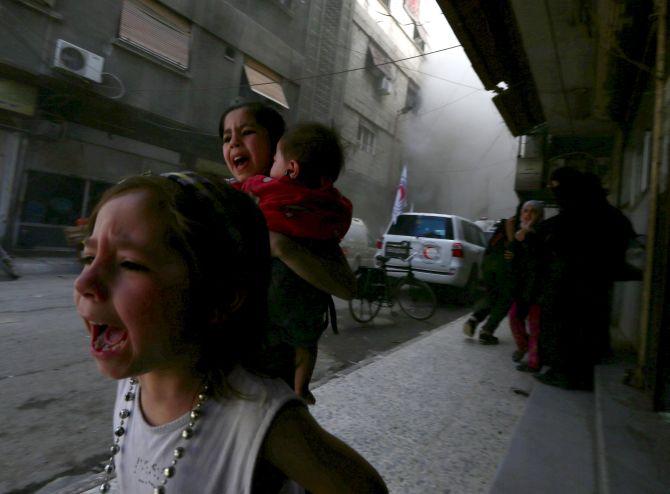
Ghazal, 4, (left) and Judy, 7, carrying 8-month-old Suhair, run away after the shelling of a Red Crescent convoy in Damascus, Syria on May 6.
The story: I was covering the Syrian Arab Red Crescent convoy’s visit to the Douma neighborhood of Damascus, which was carrying medical aid and supplies used to give psychological support to children affected by war. Every time the aid convoy arrived, children would gather around it, happy that they were going to be supplied with food and medicine.
Before the shell landed on the convoy I was sitting on the pavement relaxing; the children gathered around me so I could photograph them. While I was taking these photos, the shell exploded. It killed a female volunteer and wounded many people and volunteers nearby.
The children were terrified and began to scream and cry, especially when they saw a female volunteer covered with blood from a head injury. The challenge to portray this image was just like the challenges we face daily in time of war. I knew that there might be another shell falling within a matter of seconds; then one did exactly that a little further away. Do you want to protect yourself, like everyone else, by walking into a shop or home? Help carry the injured or be satisfied to take photos while others transfer them to ambulances? Do you want to calm screaming children? Or do you just want to cry because of what’s happened?
All these questions need answers in a matter of seconds before you can capture such an image. In this particular photograph, it was the first time I had seen how children’s innocent laughter could turn into screams, fear and tears. It was a very sad moment when I put my eye to the viewfinder to take pictures of laughing children; then when I looked back after taking the picture, I saw the same children crying, distraught. It takes only a few seconds for life to turn to ashes and blood.
Photograph: Bassam Khabieh/Reuters
The story: I was covering the Syrian Arab Red Crescent convoy’s visit to the Douma neighborhood of Damascus, which was carrying medical aid and supplies used to give psychological support to children affected by war. Every time the aid convoy arrived, children would gather around it, happy that they were going to be supplied with food and medicine.
Before the shell landed on the convoy I was sitting on the pavement relaxing; the children gathered around me so I could photograph them. While I was taking these photos, the shell exploded. It killed a female volunteer and wounded many people and volunteers nearby.
The children were terrified and began to scream and cry, especially when they saw a female volunteer covered with blood from a head injury. The challenge to portray this image was just like the challenges we face daily in time of war. I knew that there might be another shell falling within a matter of seconds; then one did exactly that a little further away. Do you want to protect yourself, like everyone else, by walking into a shop or home? Help carry the injured or be satisfied to take photos while others transfer them to ambulances? Do you want to calm screaming children? Or do you just want to cry because of what’s happened?
All these questions need answers in a matter of seconds before you can capture such an image. In this particular photograph, it was the first time I had seen how children’s innocent laughter could turn into screams, fear and tears. It was a very sad moment when I put my eye to the viewfinder to take pictures of laughing children; then when I looked back after taking the picture, I saw the same children crying, distraught. It takes only a few seconds for life to turn to ashes and blood.
Photograph: Bassam Khabieh/Reuters
When a protester was run over by a truck
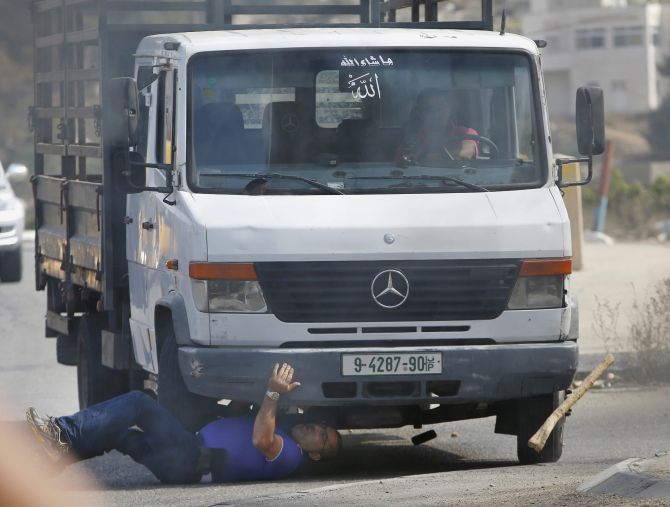
A Palestinian hits an Israeli motorist in the West Bank city of Hebron on October 20.
The story: I have seen people getting shot and killed. But this was especially terrifying because it was so violent. A Palestinian vehicle ran over and killed an Israeli motorist. The Israeli driver had been using a club to hit Palestinian protesters and cars on a roadside in the Israeli-occupied West Bank.
Israeli police said the man had stopped his car and got out after stones were thrown at it. The driver of the Palestinian vehicle, which the Israeli had hit with his club, later turned himself in.
Israeli police said it was not clear if the Israeli had been run over deliberately. Amid the tension, fear and danger, I remember breathing slowly to control my nerves. I was taking photos of everything -- the stone throwing at the Israeli cars, the reaction of the settler with his club, especially when the truck ran him over. I did not think about stopping even if what was happening was unbelievable and shocking.
As a photographer I never expected to take a picture of someone being dragged and crushed under a truck’s wheels. What happened was so unnerving because the settler was killed in this way.
Capturing a moment that will never happen again is the hard core of photojournalism. Despite the shocking moment I was lucky to keep control of my mind and do my job as a photographer: to tell the story. What I had learnt from previous experience served me well that day. Firstly don’t think about what is happening in front of you. Secondly don’t hesitate, point your camera and do your job. You will have all the time to think about it afterwards. That day reminded me that as a photographer, anything can happen.
Photograph: Mussa Qawasma/Reuters
The story: I have seen people getting shot and killed. But this was especially terrifying because it was so violent. A Palestinian vehicle ran over and killed an Israeli motorist. The Israeli driver had been using a club to hit Palestinian protesters and cars on a roadside in the Israeli-occupied West Bank.
Israeli police said the man had stopped his car and got out after stones were thrown at it. The driver of the Palestinian vehicle, which the Israeli had hit with his club, later turned himself in.
Israeli police said it was not clear if the Israeli had been run over deliberately. Amid the tension, fear and danger, I remember breathing slowly to control my nerves. I was taking photos of everything -- the stone throwing at the Israeli cars, the reaction of the settler with his club, especially when the truck ran him over. I did not think about stopping even if what was happening was unbelievable and shocking.
As a photographer I never expected to take a picture of someone being dragged and crushed under a truck’s wheels. What happened was so unnerving because the settler was killed in this way.
Capturing a moment that will never happen again is the hard core of photojournalism. Despite the shocking moment I was lucky to keep control of my mind and do my job as a photographer: to tell the story. What I had learnt from previous experience served me well that day. Firstly don’t think about what is happening in front of you. Secondly don’t hesitate, point your camera and do your job. You will have all the time to think about it afterwards. That day reminded me that as a photographer, anything can happen.
Photograph: Mussa Qawasma/Reuters
A thirst like no other
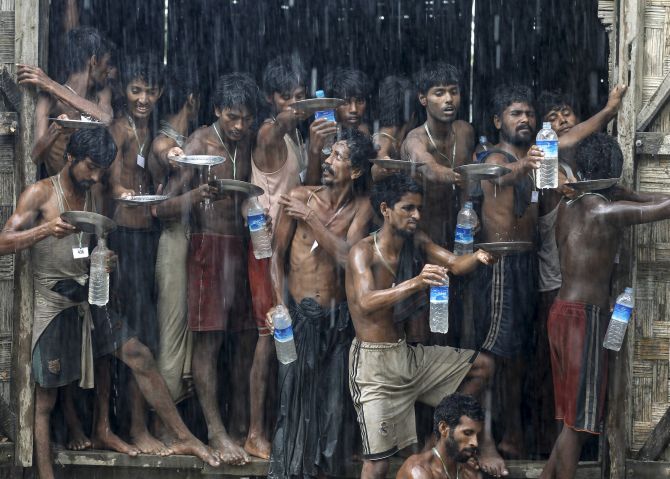
Migrants collect rainwater at a temporary refugee camp near Kanyin Chaung jetty, in Myanmar on June 4.
The story: This group of Rohingya and Bangladeshi migrants were rescued from a boat carrying 734 people off Myanmar’s southern coast. Those on board had been at sea for more than two months -- at the end with little food or water. The men in this photo were part of a group of 400 crammed into a warehouse by Myanmar police.
They had arrived the day before, but while the women, children and some men had already been moved, these men were left behind. There was no sign of the UN refugee agency UNHCR or foreign aid agencies.
Just moments before this shot, the sky opened and the monsoon rains started coming down. The men were jostling with each other for space to catch water in their bottles and plates. The authorities were hesitant to grant us access at first, but as the morning wore on and the rains started, we were able to enter and start photographing and speaking to migrants.
Just after taking this photo, the men were loaded into buses and trucks and driven to a camp where international aid agencies were waiting. I have worked on long and difficult assignments where I have gone days without a proper shower.
But for these people it had been months without enough water. Everyone was dirty and had likely washed little while at sea. I could see just how meaningful it was for them to suddenly have a chance to drink and clean themselves with whatever small amount of water they could capture.
Photograph: Soe Zeya Tun/Reuters
The story: This group of Rohingya and Bangladeshi migrants were rescued from a boat carrying 734 people off Myanmar’s southern coast. Those on board had been at sea for more than two months -- at the end with little food or water. The men in this photo were part of a group of 400 crammed into a warehouse by Myanmar police.
They had arrived the day before, but while the women, children and some men had already been moved, these men were left behind. There was no sign of the UN refugee agency UNHCR or foreign aid agencies.
Just moments before this shot, the sky opened and the monsoon rains started coming down. The men were jostling with each other for space to catch water in their bottles and plates. The authorities were hesitant to grant us access at first, but as the morning wore on and the rains started, we were able to enter and start photographing and speaking to migrants.
Just after taking this photo, the men were loaded into buses and trucks and driven to a camp where international aid agencies were waiting. I have worked on long and difficult assignments where I have gone days without a proper shower.
But for these people it had been months without enough water. Everyone was dirty and had likely washed little while at sea. I could see just how meaningful it was for them to suddenly have a chance to drink and clean themselves with whatever small amount of water they could capture.
Photograph: Soe Zeya Tun/Reuters
Crossing over for a better life
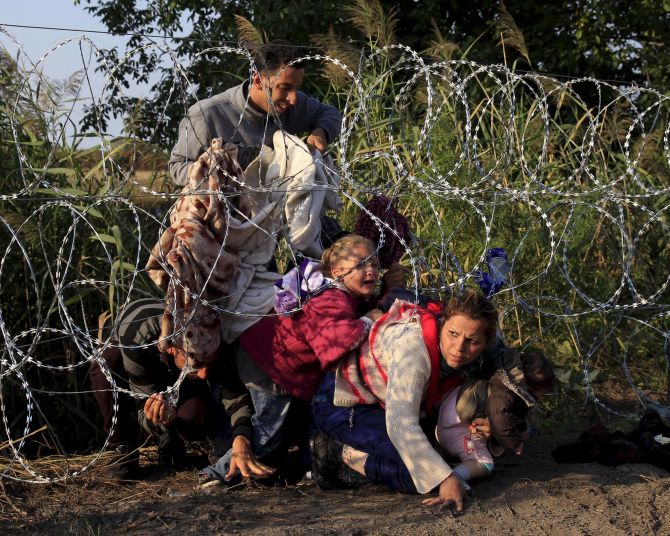
Syrian migrants cross under a fence into Hungary at the border with Serbia, near Roszke in August.
The story: Rail tracks, unguarded, line the border with Serbia. Most refugees used the tracks, a few miles long, as a highway into Hungary. I arrived at the border every day at 6.00 am. The crossing was the only spot still not blocked. A triple coil of razor wire was up everywhere else as Hungary prepared to fence off the border. The rail crossing was easy enough but many migrants chose to jump the fence to avoid the police waiting a few hundred metres inside. The razors were not too sharp to handle with heavy gloves.
Dozens of other photographers and I paced the fence, some way from the rail tracks. Among the shrubs we could make out the contours of migrants waiting for the right moment. Everyone watched everyone else. We watched the refugees, who watched the police, who watched us. It was like an elaborate board game. It was more than just waiting. The people on the other side of the fence filled the atmosphere with strange, unspeakable tension.
This family decided they had waited enough. They started for the fence. Aware of the stakes, they lifted the razor wire, looked around, then went for it. Once across they vanished in the woods. I never saw them again. Photographing the migrants was the ultimate test of staying out of the story: observe keenly, wait, shoot. Don’t cut the wire, don’t invite the refugees in, don’t alert the police. There was little human contact with the thousands of refugees scaling the fence. You learnt nothing about them. They came and went. But those who walked along the tracks stopped and talked. They accepted water or the odd chocolate bar. They even shared stories - stories that will haunt me forever.
There is no way to shake the emotional impact. Once I put the camera down and had time to reflect it all came back. You have to let the story wash through you to remain human.
Photograph: Bernardett Szabo/Reuters
The story: Rail tracks, unguarded, line the border with Serbia. Most refugees used the tracks, a few miles long, as a highway into Hungary. I arrived at the border every day at 6.00 am. The crossing was the only spot still not blocked. A triple coil of razor wire was up everywhere else as Hungary prepared to fence off the border. The rail crossing was easy enough but many migrants chose to jump the fence to avoid the police waiting a few hundred metres inside. The razors were not too sharp to handle with heavy gloves.
Dozens of other photographers and I paced the fence, some way from the rail tracks. Among the shrubs we could make out the contours of migrants waiting for the right moment. Everyone watched everyone else. We watched the refugees, who watched the police, who watched us. It was like an elaborate board game. It was more than just waiting. The people on the other side of the fence filled the atmosphere with strange, unspeakable tension.
This family decided they had waited enough. They started for the fence. Aware of the stakes, they lifted the razor wire, looked around, then went for it. Once across they vanished in the woods. I never saw them again. Photographing the migrants was the ultimate test of staying out of the story: observe keenly, wait, shoot. Don’t cut the wire, don’t invite the refugees in, don’t alert the police. There was little human contact with the thousands of refugees scaling the fence. You learnt nothing about them. They came and went. But those who walked along the tracks stopped and talked. They accepted water or the odd chocolate bar. They even shared stories - stories that will haunt me forever.
There is no way to shake the emotional impact. Once I put the camera down and had time to reflect it all came back. You have to let the story wash through you to remain human.
Photograph: Bernardett Szabo/Reuters
A bloody evening in Paris

An injured man is carried out of the Bataclan following fatal shootings in Paris, France, in November.
The story: The weekend appeared calm. I had the evening off. Just before 10, the phone rang: in a grave voice my editor told me that a shooting had occurred at a cafe in eastern Paris and I should get there as quickly as possible.
Around the same time, colleagues who were covering the France v Germany match heard explosions at the Stade de France. They turned their lenses away from the match and scanned the crowd to try and catch something. I took the bulletproof vest from my car -- it had been there since the Charlie Hebdo attacks in January -- and got on my scooter. I stopped by the bureau to pick up a 400mm lens, certain that the security perimeter would be wide.
En route I heard about another shooting incident. When I arrived at the Bataclan, police warned journalists that we could be considered targets. They ordered us to take cover. The streets were silent. Security forces evacuated some victims, who were taken to safety. Special Forces units started arriving on the scene in huge numbers.
With two colleagues we decided to seek shelter. A young man let us into his apartment and we took up position at the windows. Just before midnight explosions were heard at the music hall. We could not see what was happening; no angle gave us a direct view to the entrance to the Bataclan.
Once the Special Forces operation finished, people covered in blood and wrapped in blankets came flooding out of the theatre. We descended from our window perches to photograph the victims. We tried to record the emotion that these instants provided. Some people, covered in blood, spoke to us. Their stories were chilling. The moments they lived will remain with them forever. They also mark the life of a photojournalist.
Photograph: Christian Hartmann/Reuters
The story: The weekend appeared calm. I had the evening off. Just before 10, the phone rang: in a grave voice my editor told me that a shooting had occurred at a cafe in eastern Paris and I should get there as quickly as possible.
Around the same time, colleagues who were covering the France v Germany match heard explosions at the Stade de France. They turned their lenses away from the match and scanned the crowd to try and catch something. I took the bulletproof vest from my car -- it had been there since the Charlie Hebdo attacks in January -- and got on my scooter. I stopped by the bureau to pick up a 400mm lens, certain that the security perimeter would be wide.
En route I heard about another shooting incident. When I arrived at the Bataclan, police warned journalists that we could be considered targets. They ordered us to take cover. The streets were silent. Security forces evacuated some victims, who were taken to safety. Special Forces units started arriving on the scene in huge numbers.
With two colleagues we decided to seek shelter. A young man let us into his apartment and we took up position at the windows. Just before midnight explosions were heard at the music hall. We could not see what was happening; no angle gave us a direct view to the entrance to the Bataclan.
Once the Special Forces operation finished, people covered in blood and wrapped in blankets came flooding out of the theatre. We descended from our window perches to photograph the victims. We tried to record the emotion that these instants provided. Some people, covered in blood, spoke to us. Their stories were chilling. The moments they lived will remain with them forever. They also mark the life of a photojournalist.
Photograph: Christian Hartmann/Reuters
Hope floats
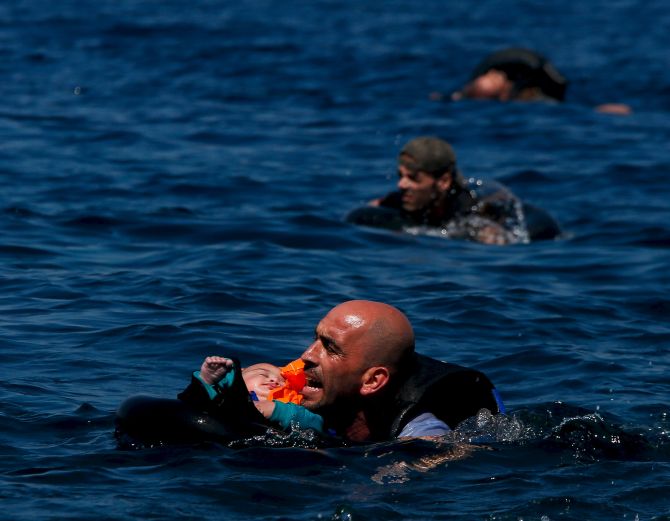
This image from September captures a Syrian refugee holding a baby swims towards the Greek island of Lesbos.
The story: Another inflatable boat packed with dozens of migrants and refugees heading towards the shore. That’s what I noticed in the distance. The sea was calm and they were cheering on the dinghy. Suddenly, some 200 metres away, the rear of the boat deflated for no obvious reason, and people started falling into the sea.
Screams replaced cheers as they frantically tried to stay afloat on life tubes, or by clinging on to the boat. Those who could swim tried to help those who couldn’t. As this dramatic scene unfolded and people drifted away from each other, the biggest challenge was to capture as many of the different scenes as I could.
There were people falling overboard; two men trying to keep their friend afloat; a man still on the boat lifting his child in the air; another man, nearing collapse from exhaustion, swimming towards the shore; volunteers rushing towards the boat. In this hectic moment, one man, tense and yelling really loudly, caught my eye so I shot some frames.
Later, as he tried to catch his breath on the beach, I asked him where he was from. “Syria,” he told me before heading towards a volunteer holding a baby. The distance of the shot hadn’t allowed me to see the details of the picture clearly. It was only when I began editing that I could make out the tiny head of a baby in a life tube, and the screaming man trying to keep himself and the baby above water.
Everything I cover, from riots to politics and sports, trains me to be on the alert and try to get the best from what I am shooting. I learned from this experience that disaster can occur even in what appears to be the calmest of situations.
Looking back, the most memorable moment was when I opened the picture and saw the baby, who looked fast asleep as if in a cradle - dreaming or listening to a lullaby.
Photograph: Alkis Konstantinidis/Reuters
The story: Another inflatable boat packed with dozens of migrants and refugees heading towards the shore. That’s what I noticed in the distance. The sea was calm and they were cheering on the dinghy. Suddenly, some 200 metres away, the rear of the boat deflated for no obvious reason, and people started falling into the sea.
Screams replaced cheers as they frantically tried to stay afloat on life tubes, or by clinging on to the boat. Those who could swim tried to help those who couldn’t. As this dramatic scene unfolded and people drifted away from each other, the biggest challenge was to capture as many of the different scenes as I could.
There were people falling overboard; two men trying to keep their friend afloat; a man still on the boat lifting his child in the air; another man, nearing collapse from exhaustion, swimming towards the shore; volunteers rushing towards the boat. In this hectic moment, one man, tense and yelling really loudly, caught my eye so I shot some frames.
Later, as he tried to catch his breath on the beach, I asked him where he was from. “Syria,” he told me before heading towards a volunteer holding a baby. The distance of the shot hadn’t allowed me to see the details of the picture clearly. It was only when I began editing that I could make out the tiny head of a baby in a life tube, and the screaming man trying to keep himself and the baby above water.
Everything I cover, from riots to politics and sports, trains me to be on the alert and try to get the best from what I am shooting. I learned from this experience that disaster can occur even in what appears to be the calmest of situations.
Looking back, the most memorable moment was when I opened the picture and saw the baby, who looked fast asleep as if in a cradle - dreaming or listening to a lullaby.
Photograph: Alkis Konstantinidis/Reuters
Lookout, there’s a hippo on the street!
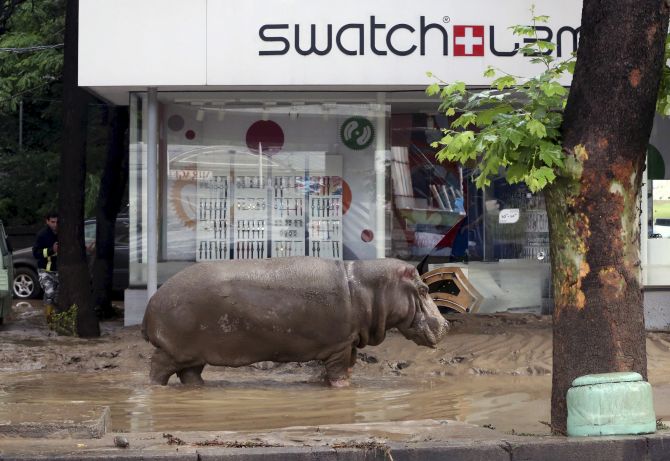
In June, Tbilisi was lashed with heavy rains, causing many animals, including this hippopotamus to flee the zoo and roam the flooded streets.
The story: The flood killed at least 12 people and partly destroyed Tbilisi Zoo, killing dozens of animals, while 30 more -- including tigers, lions and bears managed to escape from their cages. On that night the capital of Georgia was as I’d never seen it.
Among the escapees roaming the streets were a rare breed of white lion cub and six wolves, which roamed through the grounds of a children’s hospital. The zoo is right in the centre of the city, between the state broadcaster and Tbilisi State University.
Heavy rains had turned the Vere river that flows near the zoo and through Tbilisi into a torrent that washed away buildings, roads and cars. The enormous amount of mud and debris under my feet meant that making even a small movement was very difficult while shooting photos. I was there from 11:30 pm. This photo was shot at 6:00 am the next morning; my memory card was almost full so I had only a couple of shots left.
This situation was totally different from any I’d experienced before as a photographer. In the past, all my reporting experience had been negotiating with people; this was the first time I worked with animals. I was smiling as I took this photo of Begi, as I discovered it was called. I had bought a watch for my 14-year-old daughter in that shop just two days before the flood. And here was a hippo in front of it. There was only one complicated escape route available to me in case Begi decided to attack.
There were very few people around, as police had shut down the area. The distance between the hippo and me was about 25 metres but I realised that even for an animal as powerful as this one it was also quite difficult to move forward in such mud. I was also reassured that armed police would protect me in case of attack.
Today, Begi is arguably the world’s most famous hippo.
Photograph: Beso Gulashvili/Reuters
The story: The flood killed at least 12 people and partly destroyed Tbilisi Zoo, killing dozens of animals, while 30 more -- including tigers, lions and bears managed to escape from their cages. On that night the capital of Georgia was as I’d never seen it.
Among the escapees roaming the streets were a rare breed of white lion cub and six wolves, which roamed through the grounds of a children’s hospital. The zoo is right in the centre of the city, between the state broadcaster and Tbilisi State University.
Heavy rains had turned the Vere river that flows near the zoo and through Tbilisi into a torrent that washed away buildings, roads and cars. The enormous amount of mud and debris under my feet meant that making even a small movement was very difficult while shooting photos. I was there from 11:30 pm. This photo was shot at 6:00 am the next morning; my memory card was almost full so I had only a couple of shots left.
This situation was totally different from any I’d experienced before as a photographer. In the past, all my reporting experience had been negotiating with people; this was the first time I worked with animals. I was smiling as I took this photo of Begi, as I discovered it was called. I had bought a watch for my 14-year-old daughter in that shop just two days before the flood. And here was a hippo in front of it. There was only one complicated escape route available to me in case Begi decided to attack.
There were very few people around, as police had shut down the area. The distance between the hippo and me was about 25 metres but I realised that even for an animal as powerful as this one it was also quite difficult to move forward in such mud. I was also reassured that armed police would protect me in case of attack.
Today, Begi is arguably the world’s most famous hippo.
Photograph: Beso Gulashvili/Reuters